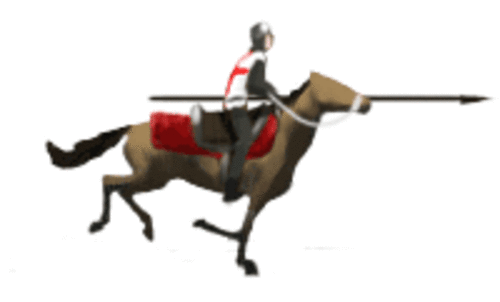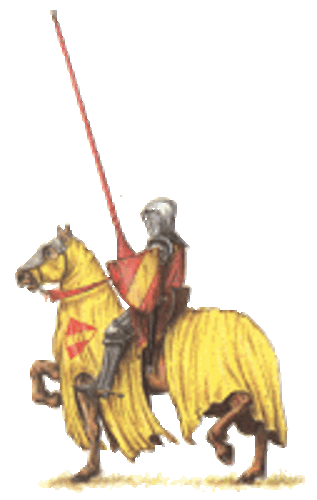Linton Dragon Slayer
Welcome to the LINTON Chronicles
John SOMERVILLE (1150-1211) & Katherine HALLIDAY (1160-1220)
page established July 2011 ![]()

Linton Research Fund Inc., Publication © 1987-2024 "Digging for our Roots"

John SOMERVILLE (1150-1211)
Dragon Slayer, Sir Knight, Baron Lintone, Royal Falconer, Sheriff of Roxburghshire
Terry L. Linton © 1977
Linton Group Limited Publication © 1984
LINTON Chronicles Volume I, Issue 3, © Fall 1984
Linton Research Fund Inc., Publication © 1987
Linton Research Fund Inc., Publication © 2011
LINTON Chronicles Volume XVIV, Issue 2, Summer © 2024, ISSN 1941-3521
_____________________________________
John SOMERVILLE (1150-1211) & Katherine HALLIDAY (1160-1220) were the 24th great-grandparents of Charles “Charlie” Edward LINTON and the 25th great-grandparents of Kirk Louis LINTON (1914-1987)
Parents
Sir knight John SOMERVILLE, (1150-1211) 1st Baron Lintone, was the son of Rogier de SÉMERVILLE (1118–1195) Baron Wychnor & Edilene "Edith" Le BOTELER of (1120–1185) Ingleby. Rogier was born in 1118 and in Wychnor, Burton-upon-Trent, County Staffordshire, England and died in 1185 at Linton Tower, Linton, Linton Parish, Roxburghshire, Scotland. Edilene was the daughter of Robert (Pincerna) Le BOTELER (1085–1169) Baron Boteler, Ingleby and Stockton & Isolde FITZWILLIAM (1089–1172). Edilene was born in 1120 in Ingleby Castle, Stokesley, Derbyshire, England and died in 1185 in Oversley, Alcester, Warwickshire, England.
John was born in 1150 in Carnwath, Lanarshire, Scotland. He was granted knighthood for extraordinary valor in combat. Sir John Linton resettled from Carnwath to Linton Parish and built Linton Tower.
John married Katherine HALLIDAY (1160-1220) circa 1170, in Carnwath, Lanarkshire, Scotland. Katherine was the daughter of Thomas HALLIDAY (1130–1194) who was born and died in Moffat, Carnwarth, Lanarkshire, Scotland.
Katherine was born in 1160, in Moffat, Carnwarth, Lanarkshire, Scotland and died after 1197 in Linton Tower, Linton Parish, Roxburghshire, Scotland.
Dragon Slayer
John of Carnwath, Lanarshire, Scotland, in 1174, encountered the Lintone Dragon, also known as the Wyrm of Wormistone, of Parish Lintone. To defeat it Somerville took a long spear to which he fixed a divot of peat dipped into a mixture of boiling pitch, resin and brimstone."
Twenty-four old John Somerville was awarded Knighthood, the Bounty lands of Gilmerton, Drum and Lintone all in Linton Parish, also the office of falconer from William the Lion King of Scotland.
Sir knight John Somerville resettled his young family from Carnwath to Linton Parish attaining the title of Baron Linton and built Linton Tower. John died in 1194 at Linton Tower, Linton village, Linton Parish, Roxburghshire, Scotland, at age 44. John or his father is buried in the choir of Linton church both were buried somewhere at Linton Church .
John & Katherine had two known children:
Roger SOMERVILLE (1170-1246) was born in 1170 in Carnwath, Lanarkshire, Scotland and died in 1246, at age 74. at Linton Tower, Linton Parish, Roxburghshire, Scotland.
William SOMERVILLE Lord van Linton was born in 1175 in Linton Tower, Linton Parish, Roxburghshire, Scotland and died in 1215 in Linton Tower, Linton Parish, Roxburghshire, Scotland, at age 40.
Tower Linton
John and his father Rogier de SÉMERVILLE built their clan stronghold on the shore of Lock Lintone on Lintone hill next to the Abbey Lintone which was built in 1160 in Romanesque style nave and chancel church on Linton knoll.
According to A Topographical Dictionary of Scotland by Samuel Lewis Year published 1846, pages 175-197:
“The lands of the Linton Parish were granted in the reign of William the Lion to John de Somerville, son of Roger, Baron of Wychnor, in England, as a reward for his having destroyed a ferocious animal which committed great depredation in the neighborhood. He was afterwards made principal falconer to the Scottish king, and sheriff of Roxburghshire; and resided in the castle of Linton, which he had founded, and which afforded an asylum to his father, Roger de Somerville, on the subsequent defeat of the English barons who had extorted from King John the grant of Magna Charta. Roger died in this castle, which continued to be the seat of his descendants till near the close of the fourteenth century, when they removed to the castle of Cowthally, in Carnwath.”
“The castle of Linton was besieged by the Earl of Surrey in the reign of Henry VIII. and razed to the ground; and scarcely any vestiges of the building are now to be traced, though, within the last forty years, a large iron door was dug out of the ruins, which appears to have belonged to the dungeon. Walter de Somerville, the third baron, was a faithful adherent to the fortunes of Wallace, under whose banner he fought against Edward I., for the defense of his country; and his son, John de Somerville, strenuously maintained the cause of Bruce, after whose defeat at Methven he was taken prisoner by the English. During the border warfare, this parish, forming part of the Dry Marches, was the principal thoroughfare between the two kingdoms, and consequently participated largely in the transactions of those times, in which the family of the Kerrs, of Graden, eminently distinguished themselves. There are still some traces in the parish of their ancient residence, which seems to have been a strong fortress, surrounded by a moat”.
Surname Linton
Sir knight John Somerville resettled his young family from Carnwath to Linton Parish attaining the title of 1st Baron Lintone and built Linton Tower. It wasn’t until John’s great-grandson William Van SOMERVILLE (1223–1283) Baron Lintone, Lord of Somerville who was born in 1223 and died on April 20, 1283, at Linton Tower, Linton, Linton Parish, Roxburghshire, Scotland was first recorded in the Roxburghshire Court Records as Willam de Linton. Most of his children where Christened in Church Linton as Lintons. Hence his family line took on the surname Linton.

Family Tradition Lore
Extracted from a genealogical MS. in the Advocates' Library, written about 168O.
“The falcon on the champion's arm, in the monument, may be supposed to allude to his office of falconer to William of Scotland”.
“John Somerville in 1174, encountered the Linton Dragon, also known as the Wyrm of Wormistone, of Parish Lintone. To defeat it Somerville took a long spear to which he fixed a divot of peat dipped into a mixture of boimling pitch, resin and brimstone." " The wode Laird of Lariestoun Slew the wode worm of Wormiestoune, and wan all Lintoan paroschine." " And further to perpetuate this actione, the barons of Lintoun, Cowthally, and Drum, did always carry for crest, a wheel, and thereon a dragoun."
“Linton & Somerville Family tradition lore says that Sir John Somerville, in 1174, slew a "monstrous animal" a serpent or dragon, that was terrorizing Lintone Parish, in County Roxburghshire. This is recorded during the Reign of King William the Lion, from December 9, 1165, to December 4, 1214”.
“John Somerville was awarded Knighthood, the Bounty land of Lintone Parish, the office of falconer from William the Lion King of Scotland.”
Extracted from The Battle Abbey Roll. Vol. III
By The Duchess of Cleveland. Prepared by Michael A. Linton.
THE ROLL OF BATTLE ABBEY A Table containing the names of the companions of William the Conqueror as displayed at Battle Abbey.
“William de Someville grandson John further obtained in 1174 the barony of Linton in Roxburghshire. According to an old MS. in the Advocate's Library, quoted by Sir Walter Scott, "he was made by King William (the lion) his principal falconer, and got from that king the lands and baronie of Linton, in Teviotdale, for an extraordinaire and valiant action, which, according to the manuscript of the family of Drum, was thus: In the parochen of Lintoun there happened to breede a monster, in forme of a serpent or worme: in length, three Scots yards, and somewhat bigger than an ordinarie man's leg, with a head more proportionable to its length than greatnesse. It had its den in a hollow piece of ground, a mile S.E. from Lintoun church: it destroyed both men and beasts that came in its way. Several attempts were made to destroy it, by shooting of arrows, and throwing of darts, none daring to approach so near as to make use of a sword or lance. John Somerville[1] undertakes to kill it, and being well mounted, and attended with a stoute servant, he cam, before the sun-rising, before the dragon's den, having prepared some long, small, and hard peats" (bog-turf dried for fuel) "bedabbled with pitch, rosett, and brimstone, fixed with a small wire upon a wheel, at the point of his lance; these, being touched with fire, would instantly break out into flames; and, there being a breath of air, that served to his purpose, about the sun-rising the worme appeared with her head and some part of her body without the den: whereupon his servant set fire to the peats upon the wheel at the top of the lance, and John Somerville, advancing with a full gallop, thrust the same with the wheel, and a great part of the lance, directly into the serpent's mouth, which wente down its throat into the belly, and was left there, the lance breaking by the re-bounding of the horse, and giving a deadly wound to the dragon; for which action he was knighted by King William; and his effigies was cut in ston in the posture he performed this actione, and placed above the principal church door of Lintoun, where it is yet to be seen, with his name and sirname; and the place where this monster was killed is at this day called the Wormes Glen. And further to perpetuate this actione, the barons of Lintoun, Cowthally, and Drum, did always carry for crest a wheel, and thereon a dragon." The rude piece of sculpture that commemorates the exploit is still in its place; and a falcon on the knight's arm probably denotes his office of falconer”
_____________________________________

“We exist because of our ancestors, let’s try not to forget them”
"That’s a beautiful and profound statement. Our ancestors’ experiences, struggles, and achievements have shaped the world we live in today. It’s important to honor and remember them, as they are a part of our history and identity”
Terry Louis Linton © 2012.

Linton Research Fund Inc., Publication © 1987-2024 "Digging for our Roots"

Check out this article
Terry Louis Linton © 1984 LINTON Chronicles
Linton Research Fund Inc., Publication © 2011
LINTON Chronicles Volume X, Issue 2, Summer © 2011, ISSN 1941-3521
____________________________________________________________________
Main Menu
Linton Research Fund, Inc., HOME PAGE
LINTON Chronicles Table of Contexts
LINTON Ancestors in the Revolutionary
LINTON Ancestors in the Civil War 1861-1865
BIRD Chronicles Table of Contents
Bird Ancestors in the Revolutionary War
BIRD Ancestors in the Civil War 1861-1865
Today's Birthdays & Anniversaries
History of the Linton Research Fund Inc., LINTON & BIRD Chronicles
LINTON & BIRD Chronicles on Facebook
![]() "Thanks for Visiting, come back when you can stay longer" Terry Louis Linton © 2007
"Thanks for Visiting, come back when you can stay longer" Terry Louis Linton © 2007
Linton Research Fund Inc., Publication © 1987-2024 “Digging for our roots”
LINTON & BIRD Chronicles
Established 1984
Quarterly Publication of the Linton Research Fund Inc. ![]()